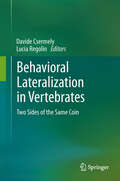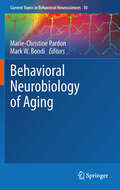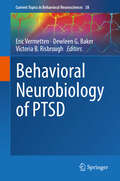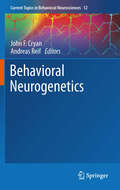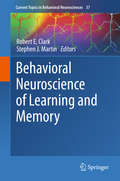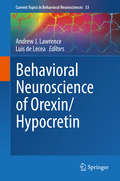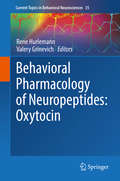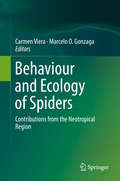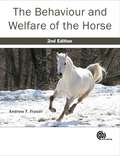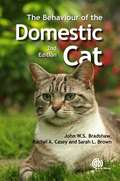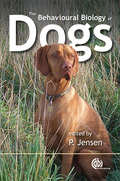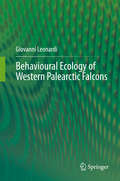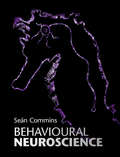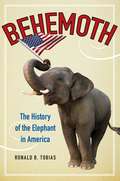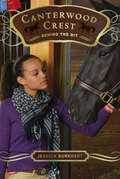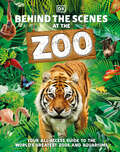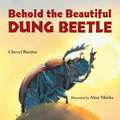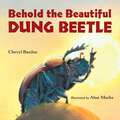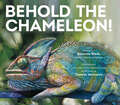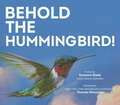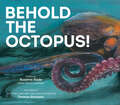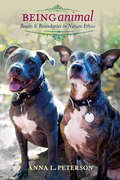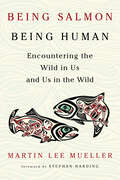- Table View
- List View
Behavioral Genetics of the Mouse
by Wim E. Crusio Frans Sluyter Robert T. Gerlai Susanna Pietropaolo Wim E. Crusio Frans Sluyter Robert T. GerlaiThe first volume in the new Cambridge Handbooks in Behavioral Genetics series, Behavioral Genetics of the Mouse provides baseline information on normal behaviors, essential in both the design of experiments using genetically modified or pharmacologically treated animals and in the interpretation and analyses of the results obtained. The book offers a comprehensive overview of the genetics of naturally occurring variation in mouse behavior, from perception and spontaneous behaviors such as exploration, aggression, social interactions and motor behaviors, to reinforced behaviors such as the different types of learning. Also included are numerous examples of potential experimental problems, which will aid and guide researchers trying to troubleshoot their own studies. A lasting reference, the thorough and comprehensive reviews offer an easy entrance into the extensive literature in this field, and will prove invaluable to students and specialists alike.
Behavioral Genetics of the Mouse Volume II
by Susanna Pietropaolo Wim E. Crusio Frans Sluyter Susanna Pietropaolo Frans SluyterThe second volume of Behavioral Genetics of the Mouse provides a comprehensive overview of the major genetically modified mouse lines used to model human neurobehavioral disorders; from disorders of perception, of autonomous and motor functions to social and cognitive syndromes, drug abuse and dependence as well as neurodegenerative pathologies. Mouse models obtained with different types of genetic manipulations (i.e. transgenic, knockout/in mice) are described in their pathological phenotypes, with a special emphasis on behavioral abnormalities. The major results obtained with many of the existing models are discussed in depth highlighting their strengths and limitations. A lasting reference, the thorough reviews offer an easy entrance into the extensive literature in this field, and will prove invaluable to students and specialists alike.
Behavioral Lateralization in Vertebrates: Two Sides of the Same Coin
by Lucia Regolin Davide CsermelyFunctional lateralization in the human brain was first identified in the classic observations by Broca in the 19th century. Only one hundred years later, however, research on this topic began anew, discovering that humans share brain lateralization not only with other mammals, but with other vertebrates and even invertebrates. Studies on lateralization have also received considerable attention in recent years due to their important evolutionary implications, becoming an important and flourishing field of investigation worldwide among ethnologists and psychologists. The chapters of this book concern the emergence and adaptive function of lateralization in several aspects of behavior for a wide range of vertebrate taxa. These studies span from how lateralization affects some aspects of fitness in fishes, or how it affects the predatory and the exploratory behavior of lizards, to navigation in the homing flights of pigeons, social learning in chicks, the influence of lateralization on the ontogeny process of chicks, and the similarity of manual lateralization (handedness) between humans and apes, our closest relatives.
Behavioral Neurobiology of Aging (Current Topics in Behavioral Neurosciences #10)
by Marie-Christine Pardon Mark W. BondiThis volume discusses the current state of research findings related to healthy brain aging by integrating human clinical studies and translational research in animal models. Several chapters offer a unique overview of successful aging, age-related cognitive decline and its associated structural and functional brain changes, as well as how these changes are influenced by reproductive aging. Insights provided by preclinical studies in mouse models and advanced neuroimaging techniques in humans are also presented.
Behavioral Neurobiology of PTSD (Current Topics in Behavioral Neurosciences #38)
by Eric Vermetten Dewleen G. Baker Victoria B. RisbroughThis volume focuses on the behavioral neuroscience that supports our understanding of the neurobiology of trauma risk and response. The collection of articles focuses on both preclinical and clinical reviews of (1) state-of-the-art knowledge of mechanisms of posttraumatic stress disorder (PTSD) and co-occurring disorders, (2) the biological and psychological constructs that support risk and resiliency for trauma disorders, and (3), novel treatment strategies and therapeutics on the horizon.
Behavioral Neurogenetics (Current Topics in Behavioral Neurosciences #12)
by Andreas Reif John F. CryanThis book covers a wide array of topics relevant to behavioral genetics from both a preclinical and clinical standpoint. Indeed in juxtaposing both areas of research the reader will appreciate the true translational nature of the field. Topics covered range from technical advances in genetic analysis in humans and animals to specific descriptions of advances in schizophrenia, attention disorders, depression and anxiety disorders, autism, aggression, neurodegeneration and neurodevelopmental disorders. The importance of gene-environment interactions is emphasised and the role of neuroimaging in unravelling the functional consequences of genetic variability described. This volume will be valued by both the basic scientist and clinician alike who may use it as a detailed reference book. It will also be of use to the novice to the field, to whom it will serve as an in-depth introduction to this exciting area of research.
Behavioral Neuroscience of Learning and Memory (Current Topics In Behavioral Neurosciences Ser. #37)
by Robert E. Clark Stephen J. Martin‘Behavioral Neuroscience of Learning and Memory’ brings together the opinions and expertise of some of the world’s foremost neuroscientists in the field of learning and memory research. The volume provides a broad coverage of contemporary research and thinking in this field, focusing both on well established topics such as the medial temporal lobe memory system, as well as emerging areas of research such as the role of memory in decision making and the mechanisms of perceptual learning. Key intersecting themes include the molecular and cellular mechanisms of memory formation, the multiplicity of memory systems in the brain, and the way in which technological innovation is driving discovery. Unusually for a volume of this kind, this volume brings together research from both humans and animals—often relatively separate areas of discourse—to give a more comprehensive and integrated view of the field. The book will be of interest to both established researchers who wish to broaden their knowledge of topics outside of their specific areas of expertise, and for students who need a resource to help them make sense of the vast scientific literature on this subject.
Behavioral Neuroscience of Orexin/Hypocretin (Current Topics in Behavioral Neurosciences #33)
by Luis De Lecea Andrew J. LawrenceThis issue of Current Topics in Behavioral Neuroscience focuses on the neuropeptide orexin (hypocretin) and brings together scientists from around the world who will provide a timely discussion of how this peptide regulates behavior. This is a fast-moving field, and with the incorporation of novel technologies, new breakthroughs are likely to continue. For example, the use of optogenetic approaches has enabled the identification of the role of orexin-containing neurons in arousal states, critical for higher order functioning. From a clinical perspective, genetic polymorphisms in hypocretin/orexin and orexin receptors are implicated in a number of psychiatric disorders. In addition, advanced clinical trials are currently underway for orexin receptor antagonists in the treatment of insomnia and sleep disorders. We aim to capture a broad audience of basic scientists and clinicians.
Behavioral Pharmacology of Neuropeptides: Oxytocin (Current Topics in Behavioral Neurosciences #35)
by Rene Hurlemann Valery GrinevichThis volume collects cutting-edge expert reviews in the oxytocin field and will be of interest to a broad scientific audience ranging from social neuroscience to clinical psychiatry. The role of the neuropeptide oxytocin in social behaviors is one of the earliest and most significant discoveries in social neuroscience. Influential studies in animal models have delineated many of the neural circuits and genetic components that underlie these behaviors. These discoveries have inspired researchers to investigate the effects of oxytocin on brain and behavior in humans and its potential relevance as a treatment for psychiatric disorders including borderline personality disorder and autism and schizophrenia spectrum disorders. In fact, there is no established social psychopharmacology in Psychiatry, and oxytocin can be seen as the first endogenous agent specifically addressing social-cognitive impairment in psychiatric disorders, with animal research suggesting that it could be especially efficient in the early postnatal period. From a human perspective, it is crucial to understand more precisely who can benefit from potential oxytocin-related treatments, which outcome measures will best represent their effects, how they should be administered, and what brain mechanisms are likely involved in mediating their effects. This type of “precision medicine” approach is in line with the research domain criteria defined by the U.S. National Institute of Mental Health.
Behaviour and Ecology of Spiders: Contributions from the Neotropical Region
by Carmen Viera Marcelo O. GonzagaWithin the last few decades, arachnology in the Neotropical region has experienced a great development filling the knowledge gap in one of the most diverse regions of the world. Nevertheless, large geographical areas remain poorly sampled, especially within the Amazon, and new genera and species have been continuously discovered, even in urban areas. In congruence with the recent improvements in research, several aspects of the ecology, behaviour and natural history of spiders, such as interactions with other predators and parasitoids, social interactions, dispersal patterns, habitat requirements, mating behaviors, among others, are being carefully investigated. These recent contributions incorporate substantial information on the preexisting knowledge on these subjects every year. Our main objective with this book is to present a summary on these new researches and on the currently knowledge on the main subjects involved in the general theme, emphasizing the contribution of the rich fauna of the Neotropical region to the research of behaviour and ecology of the spiders.
Behaviour and Welfare of the Horse
by Andrew FraserHorses play a unique role in human activities, for both work and recreation. From the ranch to the racetrack, an understanding of their behaviour and needs is vital for man to ensure their well-being. Providing a comprehensive, scientific overview of horse behaviour and its relation to welfare, this new, updated edition includes new developments in the understanding of the relationship between physiology and performance, and the neuro-chemical basis of stereotypic behaviour. It is expanded to address the important topic of welfare from both a fundamental and practical viewpoint, and will serve as an essential resource for veterinarians, equine professionals and horse owners as well as students of veterinary and animal sciences.
Behaviour of the Domestic Cat, 2nd edition
by John Bradshaw Sarah Brown Rachel CaseyThe behaviour of domesticated animals is a subject of great importance to students of animal behaviour and veterinary medicine, as well as interested pet owners. This book presents an engaging overview of the behaviour of the domestic cat, adopting both a mechanistic and functional approach. Physiological, developmental and psychological aspects are addressed, including domestication, the development of the senses, learning, communication and feeding behaviour. The authors build on these themes to discuss social behaviour, hunting and predation, cat-human interactions and welfare. Fully updated throughout, this new edition also includes two new chapters on behavioural disorders due to pathologies and from misdirected natural behaviour. It is an essential source of cat behaviour information for students, ethologists, veterinarians and pet owners.
Behavioural Biology of Dogs
by Per JensenWritten by experts in different areas, this book presents an up-to-date account of the behavioural biology of dogs. Split in 3 parts, the book addresses the specific aspects of behavioural biology. The first part deals with the evolution and development of the dog, whereas the next part deals with basic aspects of dog behaviour. The final part emphasises on the behavioural problems, their prevention and cure.
Behavioural Ecology of Western Palearctic Falcons
by Giovanni LeonardiThis monograph is the result of eight years of bibliographical and field research concerning several behavioural ecology aspects of the Palaearctic falcons. For a while, this book grew along with “The Lanner falcon” published in 2015 and revised in 2017. In both books the main aim was to provide a clear overview of the biology and ecology of these species. In fact in the last 20 years, the number of publications on falcons has grown tremendously and, in parallel, also those belonging to the so-called "grey literature". The number of people involved is also increased by including both academics and nature lovers. Many previously published books emphasized identification, and offered little insights on the behavioural and ecological aspects of the species. Very often, the research on behavioural ecology remains closed within the confines of academic community. By contrast, a multitude of basic data is scattered in countless articles published in local magazines. Many falcon species are easy to observe and study (such as kestrels) but others are more rare and localized. In order to understand the survival strategies adopted by this group of avian predators, it is necessary not to lose sight of the overall picture. This book tries to explain the different survival strategies by examining, through a few essential chapters, some crucial aspects for all species. The first chapter provides information on the genus Falco, its genetics, evolution and morphological peculiarities. The other chapters deal with reproductive strategies, competition, exploitation of resources, dispersal patterns, communication and sociality. One of the main objectives of this book is to produce an accessible but scholarly curated source of reference. By understanding the most common species, it is possible to provide a working framework for rarer, and especially threatened, falcon species.
Behavioural Neuroscience
by Seán ComminsBrain and behaviour are intrinsically linked. Animals demonstrate a huge and complex repertoire of behaviours, so how can specific behaviours be mapped onto the complicated neural circuits of the brain?<P><P> Highlighting the extraordinary advances that have been made in the field of behavioural neuroscience over recent decades, this book examines how behaviours can be understood in terms of their neural mechanisms. Each chapter outlines the components of a particular behaviour, discussing laboratory techniques, the key brain structures involved, and the underpinning cellular and molecular mechanisms.<P> Commins covers a range of topics including learning in a simple invertebrate, fear conditioning, taste aversion, sound localization, and echolocation in bats, as well as more complex behaviours, such as language development, spatial navigation and circadian rhythms. Demonstrating key processes through clear, step-by-step explanations and numerous illustrations, this will be valuable reading for students of zoology, animal behaviour, psychology, and neuroscience.<P> Provides an introduction to brain, behaviour and neurons, drawing on examples from a wide range of behaviours and species from the simplest organisms to humans.<P> Offers step-by-step explanations of the mechanisms underlying various behaviours, helping students to understand complex neural processes.<P> A summary box at the end of each chapter poses open questions, stimulating further interest and encouraging readers to think about where their research might go next.
Behemoth
by Ronald B. TobiasIn the two hundred years since their arrival in America, elephants have worked on farms, mills, mines, and railroads, in Hollywood, and in professional baseball. They've contributed to the national discourse on civil rights, immigration, politics, and capitalism. They became so deeply ingrained in the American way that they were once accorded the rights of American citizenship, including the right to vote and the right to provide testimony under oath--and they have incurred brutal punishments when convicted of human crimes. In Behemoth, Ronald B. Tobias has written the first comprehensive history of the elephant in America. As tragic as it is comic, this enthralling chronicle traces this animal's indelible footprint on American culture.
Behind the Bit
by Jessica BurkhartIn Chasing Blue, Sasha and her horse, Charm, have proven that they're worthy competitors for the elite Canterwood Crest equestrian team. Things are definitely looking up . . . until Sasha finds out who her riding partner for the semester is: her archnemesis, Queen Bee Heather. Not. Good. And when Heather starts spending a little too much QT with Sasha's almost-boyfriend, Jacob, the partnership is put to the ultimate test. The tension builds in Behind the Bit when Sasha and her team are accepted to a prestigious horse clinic. Can Sasha and Callie work together when it counts?
Behind the Scenes at the Zoo: Your All-Access Guide to the World's Greatest Zoos and Aquariums (DK Behind the Scenes)
by DKStep inside the weird and wonderful world of zoos, where all four corners of our planet come together. We&’re opening the gates, just for you! Join us on an epic behind-the-scenes adventure of zoos and aquariums. From tigers and tortoises to giraffes and jellyfish, you&’ll learn about hundreds of different animals and how they are looked after by their keepers.Inside the pages of this animal book for kids, you&’ll discover the secret delights of the world's most interesting zoos and more! It includes: • Descriptions of the conservation and ethical treatment of animals • An explanation of the vital research done by zoos. • Beautiful photos of animals and their innovative habitats in zoos around the world. • Breakdowns of the tasks of zoo staff, using language that&’s fun and accessible. All the fun of the zoo in just one book!Featuring only the best zoos from around the world, this conservation-themed children&’s book takes you on a once-in-a-lifetime trip through zoo life. It gives you a peek inside the hidden lives of the experts who care for the animals in the zoos and work passionately to conserve them in the wild, too. Learn how they create the perfect habitats, nutritious meals and fun enrichment activities to keep their animals healthy and happy. This wonderful children&’s educational book is ideal for teaching little ones about endangered animals.Behind the Scenes at the Zoo is packed with stunning images that encapsulate the essence of zoos, aquariums and wildlife parks, plus step-by-step explanations and job profiles of key roles like a zookeeper, veterinarian and wildlife biologist! It&’s the perfect gift for kids ages 9–12 who love all things animals. It&’s time to uncover the secrets of the incredible animals and army of staff that make up these extraordinary attractions and vital conservation centers! Are you ready?Take little ones on even more STEM-based journeys!If you loved this book about zoology for kids, look out for more Behind the Scenes titles from DK! Take an exclusive tour of the world's most exciting museums and discover their hidden treasures that aren't normally on public display with Behind the Scenes at the Museum.
Behold the Beautiful Dung Beetle
by Cheryl BardoeDung is a precious pile of food and drink for these beetles. <P><P>Simple science text and dramatic illustrations give a close-up view of the fascinating world of the dung beetle. When an animal lightens its load, dung beetles race to the scene. They battle over, devour, hoard, and lay their eggs in the precious poop. Dung is food, drink, and fuel for new life—as crucial to these beetles as the beetles are to many habitats, including our own. <P><P>Back matter includes instructions for finding dung beetles, fun facts, glossary, and a selected bibliography. <P><P>Lexile Measure: 1000L
Behold the Beautiful Dung Beetle
by Cheryl BardoeDung is a precious pile of food and drink for these beetles.Simple science text and dramatic illustrations give a close-up view of the fascinating world of the dung beetle. When an animal lightens its load, dung beetles race to the scene. They battle over, devour, hoard, and lay their eggs in the precious poop. Dung is food, drink, and fuel for new life—as crucial to these beetles as the beetles are to many habitats, including our own.Back matter includes instructions for finding dung beetles, fun facts, glossary, and a selected bibliography.
Behold the Chameleon
by Suzanne SladeLyrical text and gorgeous illustrations introduce us to the chameleon and its astonishing abilities.This reptilian superhero can alter the pigments in its skin cells to change color, operate its eyes separately (allowing it to keep one eye on dinner and one out for predators), capture that dinner by lashing out its long, super-fast, sticky tongue at speeds up to 13 miles an hour, and use its prehensile tail as an anchor. Ranging in size from less than an inch (Nano-chameleon, possibly the world's smallest reptile) to about two feet long, the size of a house cat (Parson's Chameleon), the chameleon is something to behold!
Behold the Hummingbird
by Suzanne SladeLyrical text and gorgeous illustrations take flight in this exploration of the tiny, gorgeous hummingbirds and its astonishing abilities.Hummingbirds are tiny and pretty, so you might find yourself taking them for granted. But these little birds are remarkable, fierce, and talented. In Behold the Hummingbird, readers will learn about species that can hover like a helicopter, fly backwards and upside down, and consume half their body weight in a single day.
Behold the Octopus!
by Suzanne SladeLyrical text and gorgeous illustrations plunge readers into an undersea exploration of the mysterious, accomplished octopus and its astonishing abilities.Behold the octopus! This remarkable animal hides beneath the seas, so you may not realize that it is one of the most incredible, talented creatures on our planet.Fortunately, this nonfiction picture book from an award-winning team reveals the fascinating features of the glorious octopus, such as lights that attract prey, legs that walk on land, and the ability to change color and shape to match their surroundings and even masquerade as other animals.Sparse, lyrical text is perfect for curious picture book readers, while sidebars and back matter share additional interesting details.
Being Animal: Beasts and Boundaries in Nature Ethics (Critical Perspectives on Animals: Theory, Culture, Science, and Law)
by Anna PetersonFor most people, animals are the most significant aspects of the nonhuman world. They symbolize nature in our imaginations, in popular media and culture, and in campaigns to preserve wilderness, yet scholars habitually treat animals and the environment as mutually exclusive objects of concern. Conducting the first examination of animals' place in popular and scholarly thinking about nature, Anna L. Peterson builds a nature ethic that conceives of nonhuman animals as active subjects who are simultaneously parts of both nature and human society. Peterson explores the tensions between humans and animals, nature and culture, animals and nature, and domesticity and wildness. She uses our intimate connections with companion animals to examine nature more broadly. Companion animals are liminal creatures straddling the boundary between human society and wilderness, revealing much about the mutually constitutive relationships binding humans and nature together. Through her paradigm-shifting reflections, Peterson disrupts the artificial boundaries between two seemingly distinct categories, underscoring their fluid and continuous character.
Being Salmon, Being Human: Encountering the Wild in Us and Us in the Wild
by Martin Lee MuellerNautilus Award Silver Medal Winner, Ecology & Environment In search of a new story for our place on earthBeing Salmon, Being Human examines Western culture&’s tragic alienation from nature by focusing on the relationship between people and salmon―weaving together key narratives about the Norwegian salmon industry as well as wild salmon in indigenous cultures of the Pacific Northwest.Mueller uses this lens to articulate a comprehensive critique of human exceptionalism, directly challenging the four-hundred-year-old notion that other animals are nothing but complicated machines without rich inner lives and that Earth is a passive backdrop to human experience. Being fully human, he argues, means experiencing the intersection of our horizon of understanding with that of other animals. Salmon are the test case for this. Mueller experiments, in evocative narrative passages, with imagining the world as a salmon might see it, and considering how this enriches our understanding of humanity in the process.Being Salmon, Being Human is both a philosophical and a narrative work, rewarding readers with insightful interpretations of major philosophers―Descartes, Heidegger, Abram, and many more―and reflections on the human–Earth relationship. It stands alongside Abram&’s Spell of the Sensuous and Becoming Animal, as well as Andreas Weber&’s The Biology of Wonder and Matter and Desire―heralding a new &“Copernican revolution&” in the fields of biology, ecology, and philosophy.&“Philosophically, scientifically, morally, and artistically, Mueller blows the [salmon] industry guys literally out of the water. If you care about the future of salmon, you must read this essential, rigorously documented book.&”―Sy Montgomery, coauthor of Tamed and Untamed; author of The Soul of an Octopus&“A marvelous exploration of what it means to belong within life&’s community. Mueller integrates imagination and analysis to produce a book of rare and important insight.&”―David George Haskell, author of The Songs of Trees

